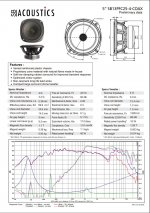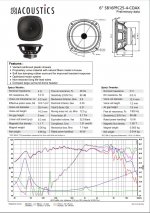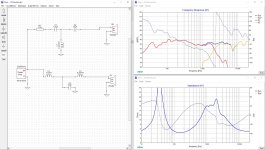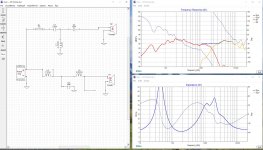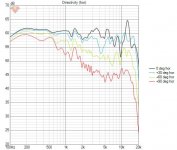Hi,
Has anyone heard/measured the SB Acoustics PFC coaxial drivers with the "factory" crossover?
SB Acoustics, SB12PFC25-4-COAX (4 inch)
SB Acoustics, SB13PFC25-4-COAX (5 inch)
SB Acoustics, SB16PFC25-4-COAX (6 inch)
I am most interested in knowing how they sound, as I am willing to use 4 or 6 of these for ATMOS and SURROUND duty.
XO are designed by SB Acoustics team and curves are optimized for 15° off-axis.
Cheers
Has anyone heard/measured the SB Acoustics PFC coaxial drivers with the "factory" crossover?
SB Acoustics, SB12PFC25-4-COAX (4 inch)
SB Acoustics, SB13PFC25-4-COAX (5 inch)
SB Acoustics, SB16PFC25-4-COAX (6 inch)
I am most interested in knowing how they sound, as I am willing to use 4 or 6 of these for ATMOS and SURROUND duty.
XO are designed by SB Acoustics team and curves are optimized for 15° off-axis.
Cheers
Attachments
For Atmos I'm sure they're OK but beware 4 ohm, I think they look like automobile drivers. But do Atmos really require much? What about just using fullrangers? Secondly im not sure about this arrangement, looks flimsy.


but beware 4 ohm
Why?
I think they look like automobile drivers.
They are not.
Secondly im not sure about this arrangement, looks flimsy.
Glass reinforced plastic baskets. These are from a very good budget driver line.
For Atmos I'm sure they're OK but beware 4 ohm, I think they look like automobile drivers. But do Atmos really require much? What about just using fullrangers? Secondly im not sure about this arrangement, looks flimsy.
Well I don't think 4ohm is going to be a problem, as there are tons of 4ohm drivers an ton of amps and AVRs that can drive that load. OTOH, SB Acoustics is know for very well design drivers and having a wide arrange of them, from good price/performance ratio to super premium line like the Satori.
I've modelled them in WinISD and seem to be quite nice, specially the 6incher. I also modelled the 4incher with 4 passive radiators, and the look very promising when crossed over 70-80Hz.
There is not much info of the crossover and how it perform, but... one would assume that SB Acoustics knows how to design a "proper" crossover. Right?
What they have written seems reasonable, especially as these are coaxes.. that these crossovers are simple and that you should first try EQ to make them sound the way you prefer.
I agree with AllenB, perhaps the filters they suggest implementing are for baffle step compensation which would depend on the dimensions of the baffle.
What they have written seems reasonable, especially as these are coaxes.. that these crossovers are simple and that you should first try EQ to make them sound the way you prefer.
It does not look to good.
This is based on "ON AXIS" response". According to the information on the XO, they are "optimized" for 15º.
Attachments
What mostly matters about this crossover is the relative contributions of each driver across the crossover region. EQing the whole system is usually done at the same time, but could just as well be done separately.
To simplify this, as long as the breakup region is out and the tweeter is dominant there etc. etc. It is good enough to get phase close without worrying too much about how close, because it is coaxial.
On the other hand, for best results you would take full polar measurements to confirm how close to ideal this is working as a coax.
To simplify this, as long as the breakup region is out and the tweeter is dominant there etc. etc. It is good enough to get phase close without worrying too much about how close, because it is coaxial.
On the other hand, for best results you would take full polar measurements to confirm how close to ideal this is working as a coax.
Is EQing (to a certain degree) possible with passive crossover network?
I am no expert, but XO seems to be around 2.500Hz which should be correct for a 5" driver.
I also assume full measurements and polars are a must for "completing" the crossover, but that makes me believe that maybe it's better to design a 2-way from the ground with another drivers and maybe with some of #augerpro waveguides...
What i mean is... would the SB acoustics designed XO for these coaxials be a good starting point? Or is it better to start all over?
I am no expert, but XO seems to be around 2.500Hz which should be correct for a 5" driver.
I also assume full measurements and polars are a must for "completing" the crossover, but that makes me believe that maybe it's better to design a 2-way from the ground with another drivers and maybe with some of #augerpro waveguides...
What i mean is... would the SB acoustics designed XO for these coaxials be a good starting point? Or is it better to start all over?
I have worked some with the 6”, it is quite good and very cheap. I came up with a different xo then sb acoustics suggested
Good!
Do you have any measurements and or more impressions on how they sound?
Also, I have to ask... would you share your XO design?
Cheers.
Do you have any measurements and or more impressions on how they sound?
Also, I have to ask... would you share your XO design?
Cheers.
Yes. It's normally done to make them flat, or have a downward tilt to the treble, or compensate the baffle step.Is EQing (to a certain degree) possible with passive crossover network?
If you are doing this by listening test then you can use different EQ, but then bring the curve back into your crossover simulator and make it permanent.
Well... being coaxial drivers have kind of an advantage phase wise (tweeter and woofer should be aligned, right?)and also I can skip measuring the vertical axis.
It would be great if someone could share they XO designes, if not... maybe its a good time to start learning how to build a proper passive network.
It would be great if someone could share they XO designes, if not... maybe its a good time to start learning how to build a proper passive network.
Phase isn't all about time alignment, but yes you should only need to measure in one plane, unless your baffle is not round.
Like any good crossover, the things you need to know can be found in polar mesurements.
Like any good crossover, the things you need to know can be found in polar mesurements.
Good!
Do you have any measurements and or more impressions on how they sound?
Also, I have to ask... would you share your XO design?
Cheers.
i have not used them for a while but these are the responses for the last xo i made
Attachments
Hi celef and mga2009
Planning on using the 6" Coax for Sourround speakers (side + rear)
Could you share the frd and zma files to play with?
I'm planning on passive filter and overall DSP correction (with ADAU1701).
The importance for me is:
Thanks, Baldin
Planning on using the 6" Coax for Sourround speakers (side + rear)
Could you share the frd and zma files to play with?
I'm planning on passive filter and overall DSP correction (with ADAU1701).
The importance for me is:
- low price (especially if I'm also going for 4 Atmos ceiling speakers .... still an IF)
- Constant directivity both vertical and horizontal
- Sound that is soft and does not make too much attention to itself (whatever that actually means 😉 )
Thanks, Baldin
Did a trace from data sheet, if anyone is interested 😉
Attachments
Side note .... just saw the Celestion TFX0615
https://celestion.com/productpdf.php?id=1031
Larger dome and therefore higher power handling ... more or less same price as the SB 6" ...... quite interesting I think
https://celestion.com/productpdf.php?id=1031
Larger dome and therefore higher power handling ... more or less same price as the SB 6" ...... quite interesting I think
- Home
- Loudspeakers
- Multi-Way
- SB Acoustics COAXIAL designs with XO


